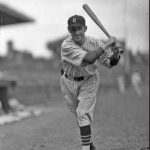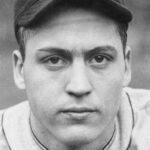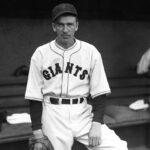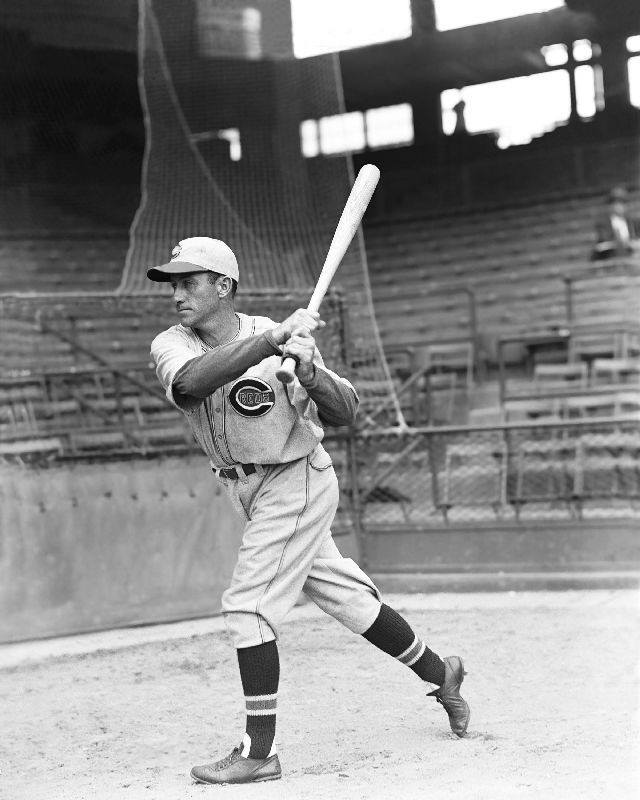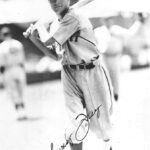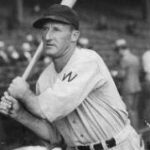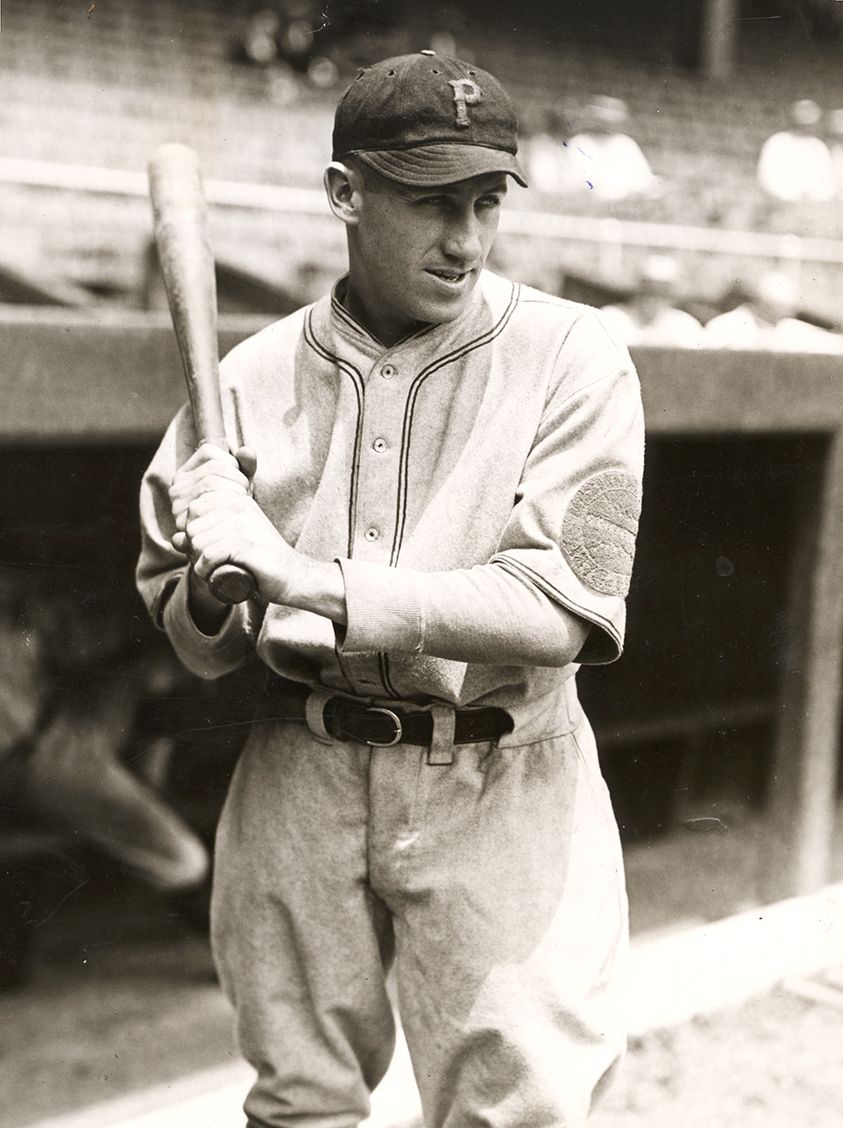Kiki Cuyler Stats & Facts
Kiki Cuyler
Position: Outfielder
Bats: Right • Throws: Right
5-10, 180lb (178cm, 81kg)
Born: August 30, 1898 in Harrisville, MI
Died: February 11, 1950 in Ann Arbor, MI
Buried: St. Ann’s Cemetery, Harrisville, MI
Debut: September 29, 1921 (5,331st in major league history)
vs. STL 3 AB, 0 H, 0 HR, 0 RBI, 0 SB
Last Game: September 14, 1938
vs. CIN 1 AB, 0 H, 0 HR, 0 RBI, 0 SB
Hall of Fame: Inducted as Player in 1968. (Voted by Veteran’s Committee)
View Kiki Cuyler’s Page at the Baseball Hall of Fame (plaque, photos, videos).
Full Name: Hazen Shirley Cuyler
Pronunciation: \KAI-kai KAI-lur\
View Player Info from the B-R Bullpen
View Player Bio from the SABR BioProject
Nine Players Who Debuted in 1921
Goose Goslin
Kiki Cuyler
Bing Miller
Luke Sewell
Riggs Stephenson
Lu Blue
Earl Sheely
Ray Kolp
Lew Fonseca
The Kiki Cuyler Teammate Team
C: Ernie Lombardi
1B: Jim Bottomley
2B: Rogers Hornsby
3B: Pie Traynor
SS: Rabbit Maranville
LF: Chuck Klein
CF: Hack Wilson
RF: Paul Waner
SP: Wilbur Cooper
SP: Charlie Root
SP: Lon Warneke
SP: Paul Derringer
RP: Burleigh Grimes
M: Charlie Grimm
Notable Events and Chronology
Biography
Superstars having trouble with management is not a product of the latter part of the twentieth century in baseball, just as any fan who knows the tale of Hazen (KiKi) Cuyler’s battle with Pirate Manager Donie Bush.
Cuyler may have been the Pirates’ most complete outfielder before Roberto Clemente. He was a line-drive hitter with terrific speed and a great arm. Cuyler was the runner-up for the National League’s Most Valuable Player Award in 1925 behind Rogers Hornsby and his eighth-inning double off Walter Johnson in the seventh game of the 1925 World Series brought baseball’s championship to the Steel City. He hit .354, .357, and .321, finished second in the league in stolen bases before leading the league in 1926. An excellent right fielder, Cuyler played well in center after Max Carey was waived to Brooklyn in 1926, but his career with the Pirates came to a prolonged end, partly due to the player’s insubordination and partly due to his manager’s rigidity.
Born in 1898, Cuyler attended the U.S. Military Academy during World War I. His speed and strength gained him notoriety on the football field but when the war ended, Cuyler got a job in the Buick factory in Flint Michigan. The post-war recession led to his hours being cut and Cuyler decided to try professional athletics. Baseball offered the best financial opportunity and Cuyler signed with the Bay City team in the Michigan-Ontario League.
While his natural athleticism was seen early, Cuyler had trouble hitting the curveball. This dissuaded some teams, but not the Pirates. However, while Cuyler’s name was mentioned as a potential outfielder in accounts of the time, he drew no more raves than players like Eddie (late Mule) Haas, Walt Mueller, Herman Layne, and Frank Luce. Cuyler got late-season call-ups to Pittsburgh from 1921-1923, but his cumulative line in the three years was ten hits in 43 at-bats.
Cuyler evidently learned to hit curveballs by 1923. Playing in Nashville, the outfielder hit .329 with 32 doubles and 15 triples. He also stole 62 bases during a time when steals were beginning to decline and was named the league’s MVP. Still, Luce who had hit .382 in the lower classed Michigan-Ontario League with 15 home runs was considered the better bet to make an impact in 1924.
KiKi made the team, but it took injuries to Max Carey and Carson Bigbee for him to get extended playing time. Taking advantage of the opportunity, Cuyler hit .360 in his first 100+ at-bats. Bill McKechnie made him his regular right fielder once his veteran outfielders returned. Cuyler’s play was seen as the chief reason the Pirates were able to emerge from a poor first half to move into third place in July. By mid-August, his average had risen to .385 and he moved into second place behind Carey in steals. Although his batting fell off somewhat down the stretch, Hazen, as he was still referred to in the press, finished at .354, two points behind third-place finisher Ross Youngs. His 16 triples were fourth in the league. Cuyler became a fan favorite and cries of “KiKi” (rhyming with “flyfly”) were chanted at Forbes Field.
The origination of Cuyler’s nickname is still disputed. Some sources say it was a shortened version of Cuyler, which he answered to and which his teammates would call out when they wanted him to take a difficult chance. Another version said that it was a childhood nickname pinned on Hazen, perhaps in a mocking way, because he stuttered.
Cuyler suffered no sophomore slump in 1925 and got off to a strong start. There were rumors in the middle of the season that the young super starter was being thrown at by rival pitchers in an attempt to scare him off the plate. Cuyler didn’t scare. On June 20, he hit two home runs, a triple and a single, and in July, he became the first National Leaguer that season to reach 100 hits besides leading the league in triples. In late August, with the pennant pretty much assured, McKechnie and the team promoted Cuyler as the league’s MVP. As noted above, he finished second to Hornsby and his .403 average, but he still compiled incredible numbers, leading the league in runs scored and triples. In fact, Cuyler’s 26 triples have not been equaled since. Additionally, Cuyler was second in total bases (366), slugging (.593), doubles (43—one behind league leader Jim Bottomley) and stolen bases (41 to Carey’s 46). His .357 average was again two points behind the number three-hitter in the league, Zack Wheat, and he drove in 102 runs. Showing speed and power, nine of Cuyler’s 18 home runs were inside-the-park, the highest figure of the lively ball era and a total which broke the team record of eight established by Chief Wilson.
KiKi continued to star in the World Series. Although his batting average was only .269, Cuyler homered in the eighth inning of Game 2 with Eddie Moore on base for a 3-2 win over Hall of Famer Stan Covaleski. In the final game, Cuyler doubled in a run in the fifth to pull the Bucs within two and sacrificed in the seventh. In the eighth, he came up with the bases full against Walter Johnson, considered by most the greatest pitcher of all time. He smashed the ball into the gap and all three runners scored. However, the umpires decided the ball had momentarily rolled under a tarp and Cuyler was credited with what became a series-deciding two-run double.
The speedster again led the league in runs scored in 1926 and he won his first stolen base title with 35. Cuyler took over the league lead in hitting in May, but with most of the team’s regulars battling slumps and the A-B-C Affair leading to the dismissal of two outfielders, Cuyler was forced to play without rest and finished at .321.
Cuyler had gotten along well with Bill McKechnie, who was something of a player’s manager and not considered a disciplinarian. McKechnie’s approach led to his contract being not renewed after the Pirates faltered in 1926. Donie Bush was brought in to tighten the reigns on Dreyfuss’s wild horses, but Cuyler had no reputation as a drinker. He was said, instead, to enjoy ice cream sodas and spent some of his off time competing in waltz contests. Still, problems developed between the two.
Cuyler injured his ankle sliding early in 1927 and missed two weeks. During his time out of action, Bush had moved rookie Lloyd Waner to center and when Cuyler was healthy enough to play, Bush moved him to left and penciled him into the number two spot in the order. Cuyler grudgingly accepted his new positions in the field and in the lineup and followed orders for a few games. He apparently sulked and complained to Bush and Bush, box scored indicate relented and moved his star to the fifth spot in the lineup. Cuyler, speaking publicly, said he did not like hitting second because his free-swinging style made him ill-suited for it and did not like playing left at Forbes Field because the sun bothered his eyes.
In a game against their rivals, the New York Giants, Cuyler went into second base standing up on a double play. He stated he had done so to force NY shortstop Travis Jackson to throw around him causing him to break up the double play. However, Jackson dropped the ball, and since Cuyler had not slid, he overran the base and was tagged out. Bush, a veteran of the Deadball era and a longtime teammate of Ty Cobb, was livid. He benched Cuyler for the remainder of the season and refused to play him during the World Series no matter what the circumstances. Clyde Barnhart hit well as Cuyler’s replacement, but when Barnhart was hurt late in the year, Bush played untested rookie Adam Comorosky over his MVP-talented doghouse dweller. Luckily for the Pirates, and undoubtedly for Bush, Comorosky did not cost the Pirates any games and the Bucs won the pennant. Bush refused to back off his hardline stance even in the World Series. He chose to use 20-year-old Fred Brickell, who had batted only 21 times during the season, and third-string catcher Roy Spencer to pinch-hit instead and once used pitcher Emil Yde as a pinch-runner rather than call on one of baseball’s fastest players.
Cuyler apologized for his insubordination in the newspapers following the Pirate’s loss to the Yankees, but he realized he would never play for the team again. Although trade rumors mentioned players such as Jackson, Highpockets Kelly, and either Dolph Luque or Pete Donohue coming in exchange for Cuyler when the trade was finally made it was to the Cubs and the Pirates received only second baseman Sparky Adams, a quick player with little power and who was 33-years-old and Floyd Scott, a decent hitting prospect without much speed. Adams did not play as well for the Pirates as he had for the Cubs and lost his starting job while Scott hit well, but saw his career end after an injury, playing in only 60 games with the Corsairs.
Cuyler, after his own injury limited his effectiveness in 1928, regained his reputation as a star with the Cubs, hitting between .317 and .360 five times over the next six seasons. After retiring as a player, Cuyler coached with the Red Sox. He died young, at the age of 51, after suffering his second heart attack in less than a week, in 1950. While generally regarded as a Cub when discussions of Hall of Famers are held (Cuyler was elected in 1968), KiKi’s time as a regular with the Pirates was so significant that the team has spotlighted him with a banner outside PNC Park. His 3 ½ seasons as a starting player are the least by someone so honored,
Factoids, Quotes, Milestones and Odd Facts
Played For
Pittsburgh Pirates (1921-1927)
Chicago Cubs (1928-1935)
Cincinnati Reds (1935-1937)
Brooklyn Dodgers (1938)
Similar: Enos Slaughter
Linked: Chick Hafey, Bill Terry, Jim Bottomley, Donie Bush
He was born Hazen Shirley Cuyler. The first name was pronounced “Cuy Cuy” not “Kee Kee,” and it was given to him by teammates who would yell “Cuy Cuy” when the ball was hit in his direction, to make sure everyone knew the play was his.
Best Season, 1925
This is without question the best season of Cuyler’s career. He batted .357 with a .598 slugging mark, a .423 OBP, 220 hits, 144 runs scored, 43 doubles, 26 triples, 18 homers, 102 RBI, 41 steals, and 369 total bases. He led the National League in games played and triples, and finished in the top ten in 16 offensive categories. Only Rogers Hornsby’s triple crown stopped Cuyler from winning a deserved MVP award.
Post-Season Appearances
1925 World Series
1929 World Series
1932 World Series
Where He Played: Right field (796 games), center (700), left (331). The statistical evidence suggests that Cuyler was an average, at best, defensive player.
Feats: In 1925, Cuyler collected hits in ten consecutive at-bats in September, to set a National League record.
Injuries and Explanation for Missed Playing Time
Piratre skipper Donie Bush, who played with Ty Cobb and learned a tging about being ornery, benched Cuyler in August of 1927, after Kiki reportedly failed to slide to break up a double play at second. Another story has it that Bush asked Cuyler to hit second in the lineup, and Kiki refused because he had a superstition about hitting third.
Hitting Streaks
22 games (1926)
22 games (1926)
Transactions
November 28, 1927: Traded by the Pittsburgh Pirates to the Chicago Cubs for Sparky Adams and Pete Scott.
Cuyler vs. The Pirates
Cuyler won a bitter contract dispute with Pirate owner Barney Dreyfuss in the spring of 1927, which placed the popular outfielder on shaky ground. In August, he failed to slide into second base on an apparent force play and was benched by manager Donie Bush (who didn’t really like Cuyler anyway), for the remainder of the season, even though Pittsburgh was in first place. The feisty skipper refused to place Cuyler in the lineup for the World Series loss against New York and at season’s end, Cuyler was shipped to the Cubs. Cuyler lasted eleven more years in the big leagues, batting .315 with more than 1,600 hits and 198 steals (the most in the loop) over that stretch.
Replaced
After waiting in the Pirate system for more than three seasons, Cuyler was finally given a job as the right-handed part of a platon in left field in 1924. The other half of the arrangement was Skeet Bigbee, who had been the Bucs starting left fielder for four seasons. After a year as a pltoon player, Cuyler was the starting right fielder in 1925, replacing Clyde “Pooch” Barnhart, who switched to left.
Replaced By
Cuyler’s last regular job was as Brooklyn’s right fielder in 1938, at least on a semi-regular basis. After he retired, in 1939, Brooklyn replaced him with “Rowdy” Moore, the beer-drinking Texan.
Best Strength as a Player
Many contemorary accounts cite Cuyler as the fastest man in the National League during his prime.
Largest Weakness as a Player
Kiki was rarely healthy and he always seemed to wear out his welcome, no matter where he played. As a player he was always one hard slide or swing away from injuring a leg or pulling a muscle. In some ways he was like Steve Kemp: he swung so hard that he’d corkscrew himself into the ground when he missed. In the field, ala Ken Griffey Jr., Cuyler frequently ran into teammates or walls, and he had a knack for throwing over the heads of his cutoff men.
Other Resources & Links




